Case Study: Health Management & Quality Use of Medicines Analysis
VerifiedAdded on 2023/03/31
|9
|2090
|160
Case Study
AI Summary
This case study focuses on Mr. T, an elderly patient with congestive heart failure, arthritis, hypertension, and hyperlipidemia, admitted to a general practice ward. Key health issues identified include a history of myocardial infarction and a high risk of falls, further complicated by cognitive decline and improper medication management. Recommendations address hypotension through vasopressor administration and volume resuscitation, along with fall risk prevention via wearable technology and occupational therapy, aiming to improve his overall health, safety, and quality of life. Desklib provides access to this and other solved assignments for students.
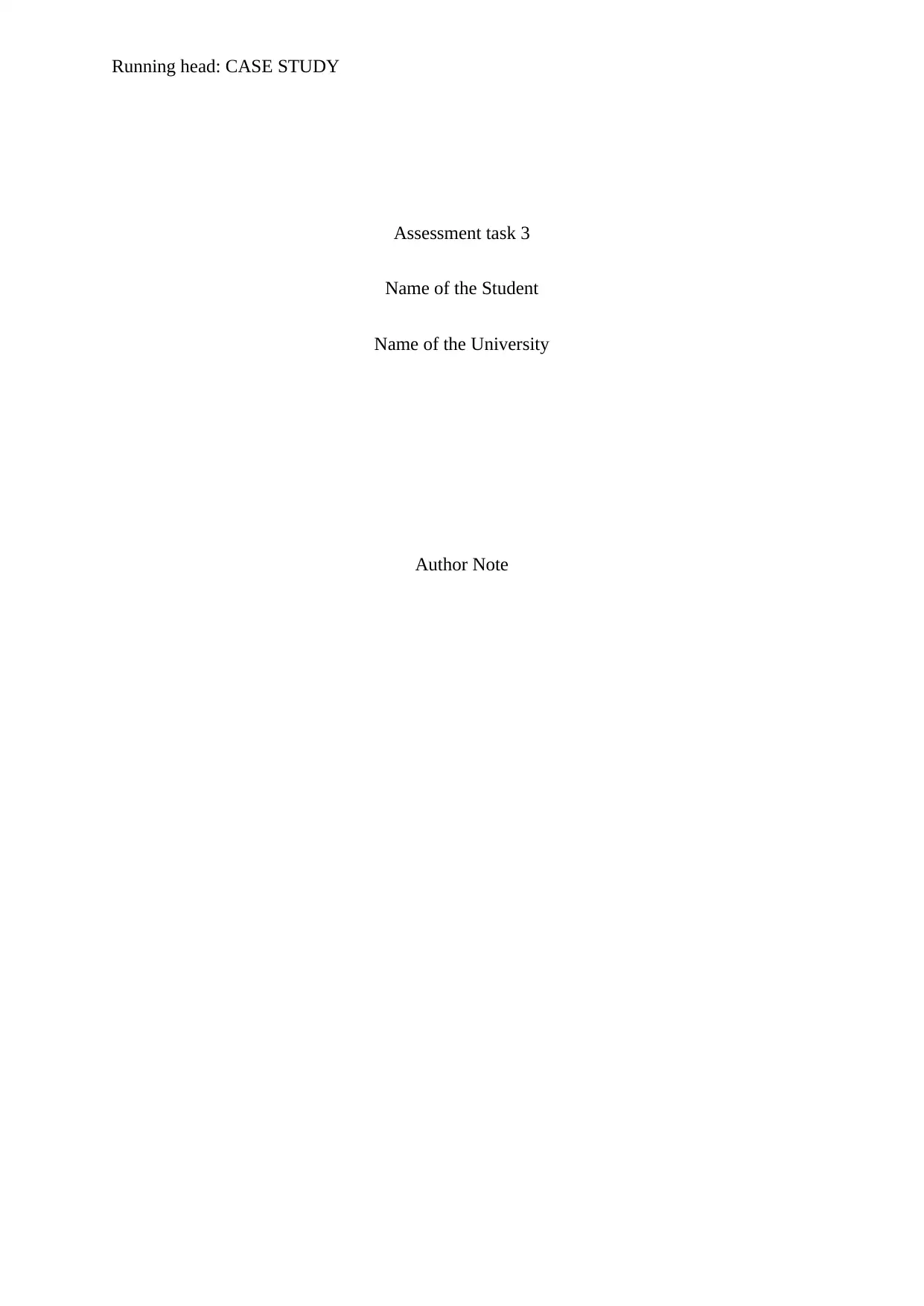
Running head: CASE STUDY
Assessment task 3
Name of the Student
Name of the University
Author Note
Assessment task 3
Name of the Student
Name of the University
Author Note
Paraphrase This Document
Need a fresh take? Get an instant paraphrase of this document with our AI Paraphraser
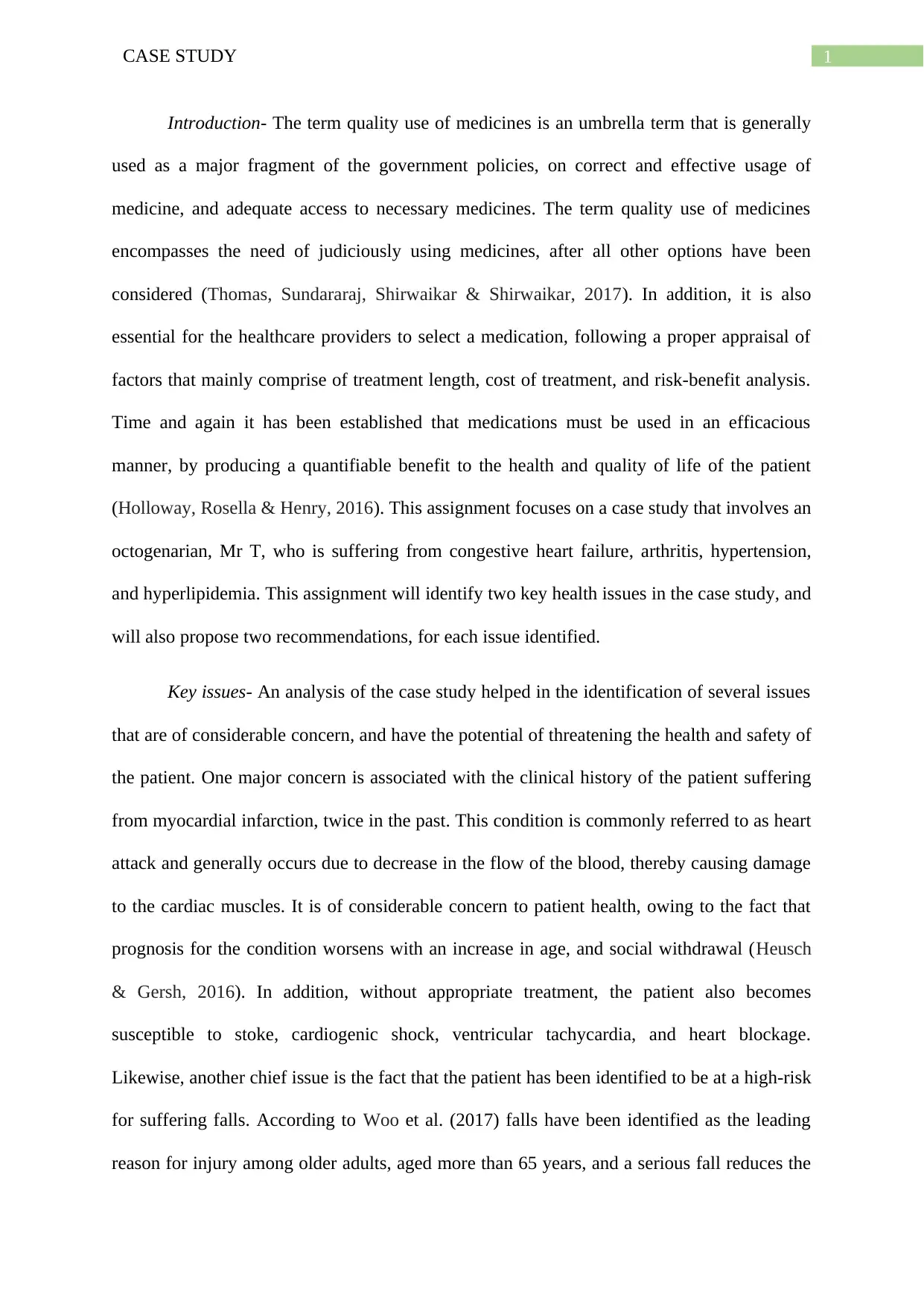
1CASE STUDY
Introduction- The term quality use of medicines is an umbrella term that is generally
used as a major fragment of the government policies, on correct and effective usage of
medicine, and adequate access to necessary medicines. The term quality use of medicines
encompasses the need of judiciously using medicines, after all other options have been
considered (Thomas, Sundararaj, Shirwaikar & Shirwaikar, 2017). In addition, it is also
essential for the healthcare providers to select a medication, following a proper appraisal of
factors that mainly comprise of treatment length, cost of treatment, and risk-benefit analysis.
Time and again it has been established that medications must be used in an efficacious
manner, by producing a quantifiable benefit to the health and quality of life of the patient
(Holloway, Rosella & Henry, 2016). This assignment focuses on a case study that involves an
octogenarian, Mr T, who is suffering from congestive heart failure, arthritis, hypertension,
and hyperlipidemia. This assignment will identify two key health issues in the case study, and
will also propose two recommendations, for each issue identified.
Key issues- An analysis of the case study helped in the identification of several issues
that are of considerable concern, and have the potential of threatening the health and safety of
the patient. One major concern is associated with the clinical history of the patient suffering
from myocardial infarction, twice in the past. This condition is commonly referred to as heart
attack and generally occurs due to decrease in the flow of the blood, thereby causing damage
to the cardiac muscles. It is of considerable concern to patient health, owing to the fact that
prognosis for the condition worsens with an increase in age, and social withdrawal (Heusch
& Gersh, 2016). In addition, without appropriate treatment, the patient also becomes
susceptible to stoke, cardiogenic shock, ventricular tachycardia, and heart blockage.
Likewise, another chief issue is the fact that the patient has been identified to be at a high-risk
for suffering falls. According to Woo et al. (2017) falls have been identified as the leading
reason for injury among older adults, aged more than 65 years, and a serious fall reduces the
Introduction- The term quality use of medicines is an umbrella term that is generally
used as a major fragment of the government policies, on correct and effective usage of
medicine, and adequate access to necessary medicines. The term quality use of medicines
encompasses the need of judiciously using medicines, after all other options have been
considered (Thomas, Sundararaj, Shirwaikar & Shirwaikar, 2017). In addition, it is also
essential for the healthcare providers to select a medication, following a proper appraisal of
factors that mainly comprise of treatment length, cost of treatment, and risk-benefit analysis.
Time and again it has been established that medications must be used in an efficacious
manner, by producing a quantifiable benefit to the health and quality of life of the patient
(Holloway, Rosella & Henry, 2016). This assignment focuses on a case study that involves an
octogenarian, Mr T, who is suffering from congestive heart failure, arthritis, hypertension,
and hyperlipidemia. This assignment will identify two key health issues in the case study, and
will also propose two recommendations, for each issue identified.
Key issues- An analysis of the case study helped in the identification of several issues
that are of considerable concern, and have the potential of threatening the health and safety of
the patient. One major concern is associated with the clinical history of the patient suffering
from myocardial infarction, twice in the past. This condition is commonly referred to as heart
attack and generally occurs due to decrease in the flow of the blood, thereby causing damage
to the cardiac muscles. It is of considerable concern to patient health, owing to the fact that
prognosis for the condition worsens with an increase in age, and social withdrawal (Heusch
& Gersh, 2016). In addition, without appropriate treatment, the patient also becomes
susceptible to stoke, cardiogenic shock, ventricular tachycardia, and heart blockage.
Likewise, another chief issue is the fact that the patient has been identified to be at a high-risk
for suffering falls. According to Woo et al. (2017) falls have been identified as the leading
reason for injury among older adults, aged more than 65 years, and a serious fall reduces the
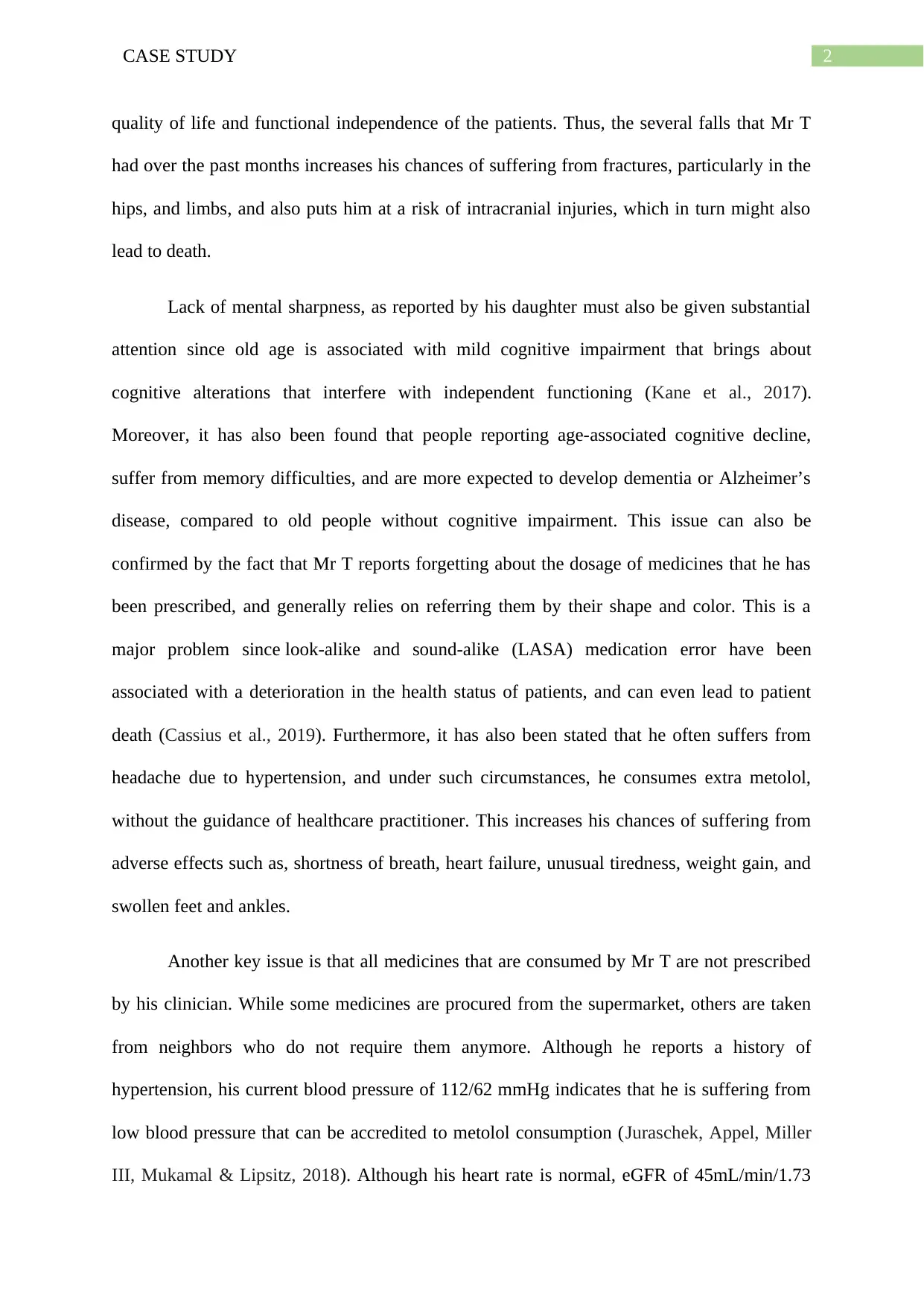
2CASE STUDY
quality of life and functional independence of the patients. Thus, the several falls that Mr T
had over the past months increases his chances of suffering from fractures, particularly in the
hips, and limbs, and also puts him at a risk of intracranial injuries, which in turn might also
lead to death.
Lack of mental sharpness, as reported by his daughter must also be given substantial
attention since old age is associated with mild cognitive impairment that brings about
cognitive alterations that interfere with independent functioning (Kane et al., 2017).
Moreover, it has also been found that people reporting age-associated cognitive decline,
suffer from memory difficulties, and are more expected to develop dementia or Alzheimer’s
disease, compared to old people without cognitive impairment. This issue can also be
confirmed by the fact that Mr T reports forgetting about the dosage of medicines that he has
been prescribed, and generally relies on referring them by their shape and color. This is a
major problem since look-alike and sound-alike (LASA) medication error have been
associated with a deterioration in the health status of patients, and can even lead to patient
death (Cassius et al., 2019). Furthermore, it has also been stated that he often suffers from
headache due to hypertension, and under such circumstances, he consumes extra metolol,
without the guidance of healthcare practitioner. This increases his chances of suffering from
adverse effects such as, shortness of breath, heart failure, unusual tiredness, weight gain, and
swollen feet and ankles.
Another key issue is that all medicines that are consumed by Mr T are not prescribed
by his clinician. While some medicines are procured from the supermarket, others are taken
from neighbors who do not require them anymore. Although he reports a history of
hypertension, his current blood pressure of 112/62 mmHg indicates that he is suffering from
low blood pressure that can be accredited to metolol consumption (Juraschek, Appel, Miller
III, Mukamal & Lipsitz, 2018). Although his heart rate is normal, eGFR of 45mL/min/1.73
quality of life and functional independence of the patients. Thus, the several falls that Mr T
had over the past months increases his chances of suffering from fractures, particularly in the
hips, and limbs, and also puts him at a risk of intracranial injuries, which in turn might also
lead to death.
Lack of mental sharpness, as reported by his daughter must also be given substantial
attention since old age is associated with mild cognitive impairment that brings about
cognitive alterations that interfere with independent functioning (Kane et al., 2017).
Moreover, it has also been found that people reporting age-associated cognitive decline,
suffer from memory difficulties, and are more expected to develop dementia or Alzheimer’s
disease, compared to old people without cognitive impairment. This issue can also be
confirmed by the fact that Mr T reports forgetting about the dosage of medicines that he has
been prescribed, and generally relies on referring them by their shape and color. This is a
major problem since look-alike and sound-alike (LASA) medication error have been
associated with a deterioration in the health status of patients, and can even lead to patient
death (Cassius et al., 2019). Furthermore, it has also been stated that he often suffers from
headache due to hypertension, and under such circumstances, he consumes extra metolol,
without the guidance of healthcare practitioner. This increases his chances of suffering from
adverse effects such as, shortness of breath, heart failure, unusual tiredness, weight gain, and
swollen feet and ankles.
Another key issue is that all medicines that are consumed by Mr T are not prescribed
by his clinician. While some medicines are procured from the supermarket, others are taken
from neighbors who do not require them anymore. Although he reports a history of
hypertension, his current blood pressure of 112/62 mmHg indicates that he is suffering from
low blood pressure that can be accredited to metolol consumption (Juraschek, Appel, Miller
III, Mukamal & Lipsitz, 2018). Although his heart rate is normal, eGFR of 45mL/min/1.73
⊘ This is a preview!⊘
Do you want full access?
Subscribe today to unlock all pages.

Trusted by 1+ million students worldwide
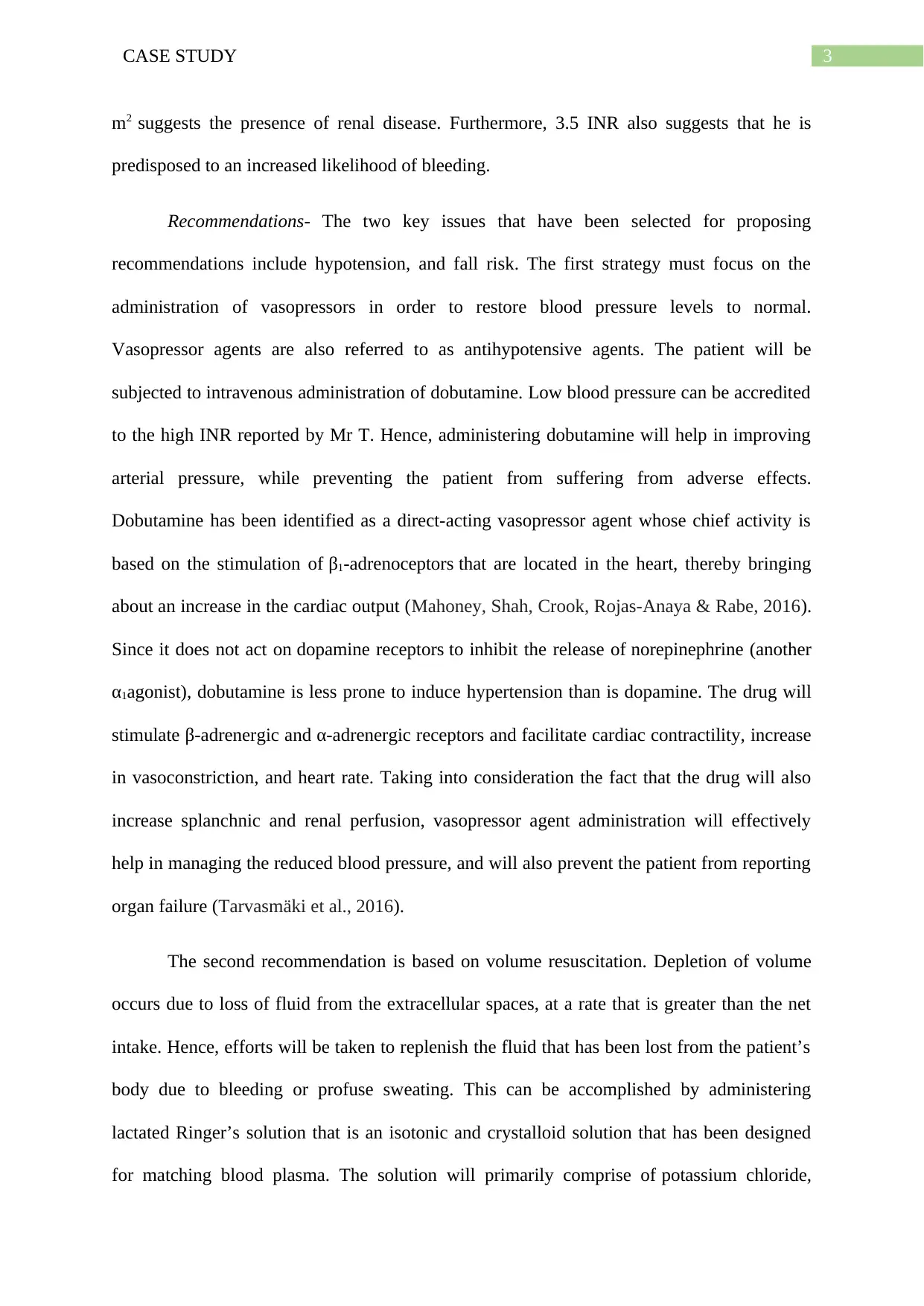
3CASE STUDY
m2 suggests the presence of renal disease. Furthermore, 3.5 INR also suggests that he is
predisposed to an increased likelihood of bleeding.
Recommendations- The two key issues that have been selected for proposing
recommendations include hypotension, and fall risk. The first strategy must focus on the
administration of vasopressors in order to restore blood pressure levels to normal.
Vasopressor agents are also referred to as antihypotensive agents. The patient will be
subjected to intravenous administration of dobutamine. Low blood pressure can be accredited
to the high INR reported by Mr T. Hence, administering dobutamine will help in improving
arterial pressure, while preventing the patient from suffering from adverse effects.
Dobutamine has been identified as a direct-acting vasopressor agent whose chief activity is
based on the stimulation of β1-adrenoceptors that are located in the heart, thereby bringing
about an increase in the cardiac output (Mahoney, Shah, Crook, Rojas-Anaya & Rabe, 2016).
Since it does not act on dopamine receptors to inhibit the release of norepinephrine (another
α1agonist), dobutamine is less prone to induce hypertension than is dopamine. The drug will
stimulate β-adrenergic and α-adrenergic receptors and facilitate cardiac contractility, increase
in vasoconstriction, and heart rate. Taking into consideration the fact that the drug will also
increase splanchnic and renal perfusion, vasopressor agent administration will effectively
help in managing the reduced blood pressure, and will also prevent the patient from reporting
organ failure (Tarvasmäki et al., 2016).
The second recommendation is based on volume resuscitation. Depletion of volume
occurs due to loss of fluid from the extracellular spaces, at a rate that is greater than the net
intake. Hence, efforts will be taken to replenish the fluid that has been lost from the patient’s
body due to bleeding or profuse sweating. This can be accomplished by administering
lactated Ringer’s solution that is an isotonic and crystalloid solution that has been designed
for matching blood plasma. The solution will primarily comprise of potassium chloride,
m2 suggests the presence of renal disease. Furthermore, 3.5 INR also suggests that he is
predisposed to an increased likelihood of bleeding.
Recommendations- The two key issues that have been selected for proposing
recommendations include hypotension, and fall risk. The first strategy must focus on the
administration of vasopressors in order to restore blood pressure levels to normal.
Vasopressor agents are also referred to as antihypotensive agents. The patient will be
subjected to intravenous administration of dobutamine. Low blood pressure can be accredited
to the high INR reported by Mr T. Hence, administering dobutamine will help in improving
arterial pressure, while preventing the patient from suffering from adverse effects.
Dobutamine has been identified as a direct-acting vasopressor agent whose chief activity is
based on the stimulation of β1-adrenoceptors that are located in the heart, thereby bringing
about an increase in the cardiac output (Mahoney, Shah, Crook, Rojas-Anaya & Rabe, 2016).
Since it does not act on dopamine receptors to inhibit the release of norepinephrine (another
α1agonist), dobutamine is less prone to induce hypertension than is dopamine. The drug will
stimulate β-adrenergic and α-adrenergic receptors and facilitate cardiac contractility, increase
in vasoconstriction, and heart rate. Taking into consideration the fact that the drug will also
increase splanchnic and renal perfusion, vasopressor agent administration will effectively
help in managing the reduced blood pressure, and will also prevent the patient from reporting
organ failure (Tarvasmäki et al., 2016).
The second recommendation is based on volume resuscitation. Depletion of volume
occurs due to loss of fluid from the extracellular spaces, at a rate that is greater than the net
intake. Hence, efforts will be taken to replenish the fluid that has been lost from the patient’s
body due to bleeding or profuse sweating. This can be accomplished by administering
lactated Ringer’s solution that is an isotonic and crystalloid solution that has been designed
for matching blood plasma. The solution will primarily comprise of potassium chloride,
Paraphrase This Document
Need a fresh take? Get an instant paraphrase of this document with our AI Paraphraser
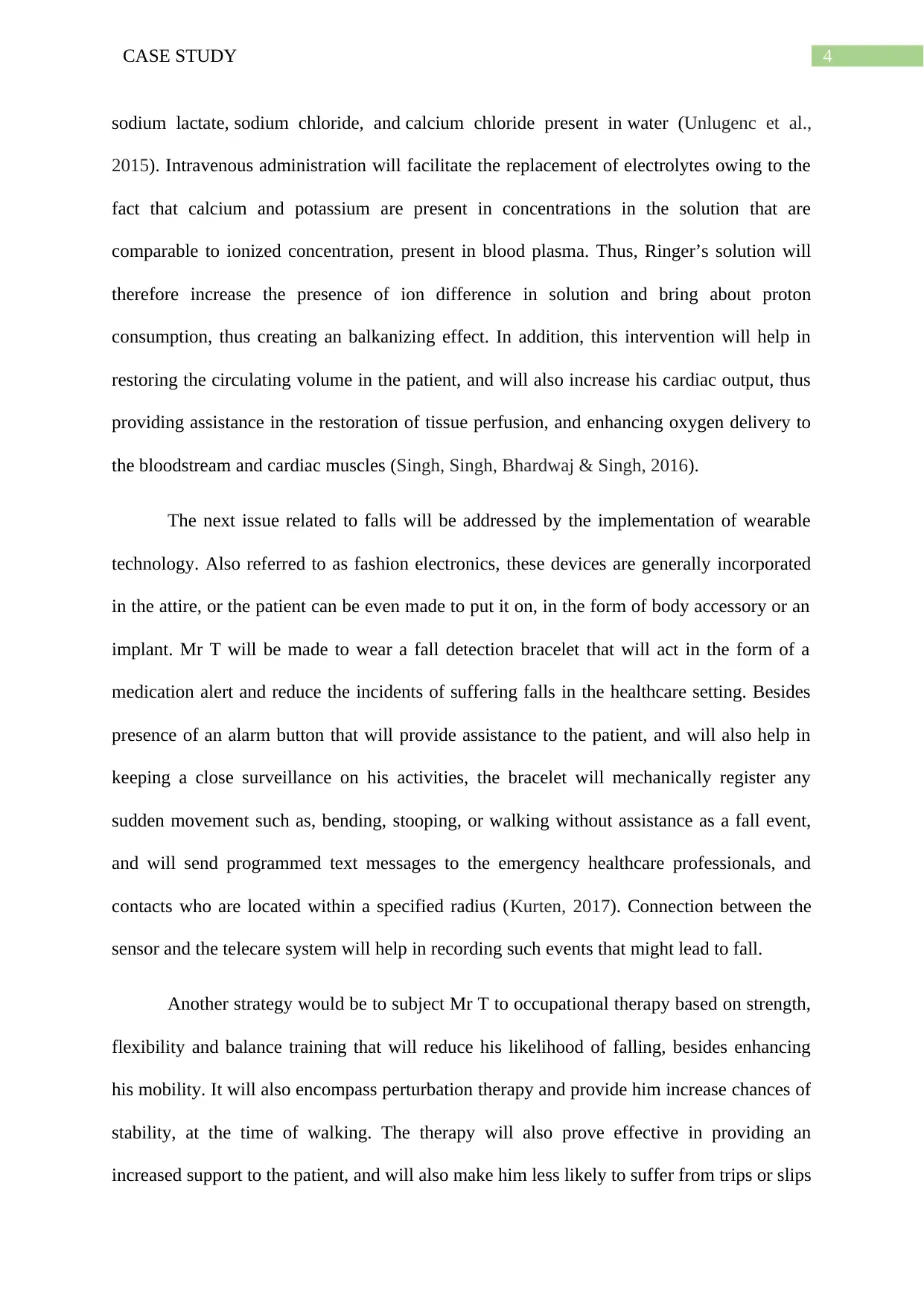
4CASE STUDY
sodium lactate, sodium chloride, and calcium chloride present in water (Unlugenc et al.,
2015). Intravenous administration will facilitate the replacement of electrolytes owing to the
fact that calcium and potassium are present in concentrations in the solution that are
comparable to ionized concentration, present in blood plasma. Thus, Ringer’s solution will
therefore increase the presence of ion difference in solution and bring about proton
consumption, thus creating an balkanizing effect. In addition, this intervention will help in
restoring the circulating volume in the patient, and will also increase his cardiac output, thus
providing assistance in the restoration of tissue perfusion, and enhancing oxygen delivery to
the bloodstream and cardiac muscles (Singh, Singh, Bhardwaj & Singh, 2016).
The next issue related to falls will be addressed by the implementation of wearable
technology. Also referred to as fashion electronics, these devices are generally incorporated
in the attire, or the patient can be even made to put it on, in the form of body accessory or an
implant. Mr T will be made to wear a fall detection bracelet that will act in the form of a
medication alert and reduce the incidents of suffering falls in the healthcare setting. Besides
presence of an alarm button that will provide assistance to the patient, and will also help in
keeping a close surveillance on his activities, the bracelet will mechanically register any
sudden movement such as, bending, stooping, or walking without assistance as a fall event,
and will send programmed text messages to the emergency healthcare professionals, and
contacts who are located within a specified radius (Kurten, 2017). Connection between the
sensor and the telecare system will help in recording such events that might lead to fall.
Another strategy would be to subject Mr T to occupational therapy based on strength,
flexibility and balance training that will reduce his likelihood of falling, besides enhancing
his mobility. It will also encompass perturbation therapy and provide him increase chances of
stability, at the time of walking. The therapy will also prove effective in providing an
increased support to the patient, and will also make him less likely to suffer from trips or slips
sodium lactate, sodium chloride, and calcium chloride present in water (Unlugenc et al.,
2015). Intravenous administration will facilitate the replacement of electrolytes owing to the
fact that calcium and potassium are present in concentrations in the solution that are
comparable to ionized concentration, present in blood plasma. Thus, Ringer’s solution will
therefore increase the presence of ion difference in solution and bring about proton
consumption, thus creating an balkanizing effect. In addition, this intervention will help in
restoring the circulating volume in the patient, and will also increase his cardiac output, thus
providing assistance in the restoration of tissue perfusion, and enhancing oxygen delivery to
the bloodstream and cardiac muscles (Singh, Singh, Bhardwaj & Singh, 2016).
The next issue related to falls will be addressed by the implementation of wearable
technology. Also referred to as fashion electronics, these devices are generally incorporated
in the attire, or the patient can be even made to put it on, in the form of body accessory or an
implant. Mr T will be made to wear a fall detection bracelet that will act in the form of a
medication alert and reduce the incidents of suffering falls in the healthcare setting. Besides
presence of an alarm button that will provide assistance to the patient, and will also help in
keeping a close surveillance on his activities, the bracelet will mechanically register any
sudden movement such as, bending, stooping, or walking without assistance as a fall event,
and will send programmed text messages to the emergency healthcare professionals, and
contacts who are located within a specified radius (Kurten, 2017). Connection between the
sensor and the telecare system will help in recording such events that might lead to fall.
Another strategy would be to subject Mr T to occupational therapy based on strength,
flexibility and balance training that will reduce his likelihood of falling, besides enhancing
his mobility. It will also encompass perturbation therapy and provide him increase chances of
stability, at the time of walking. The therapy will also prove effective in providing an
increased support to the patient, and will also make him less likely to suffer from trips or slips
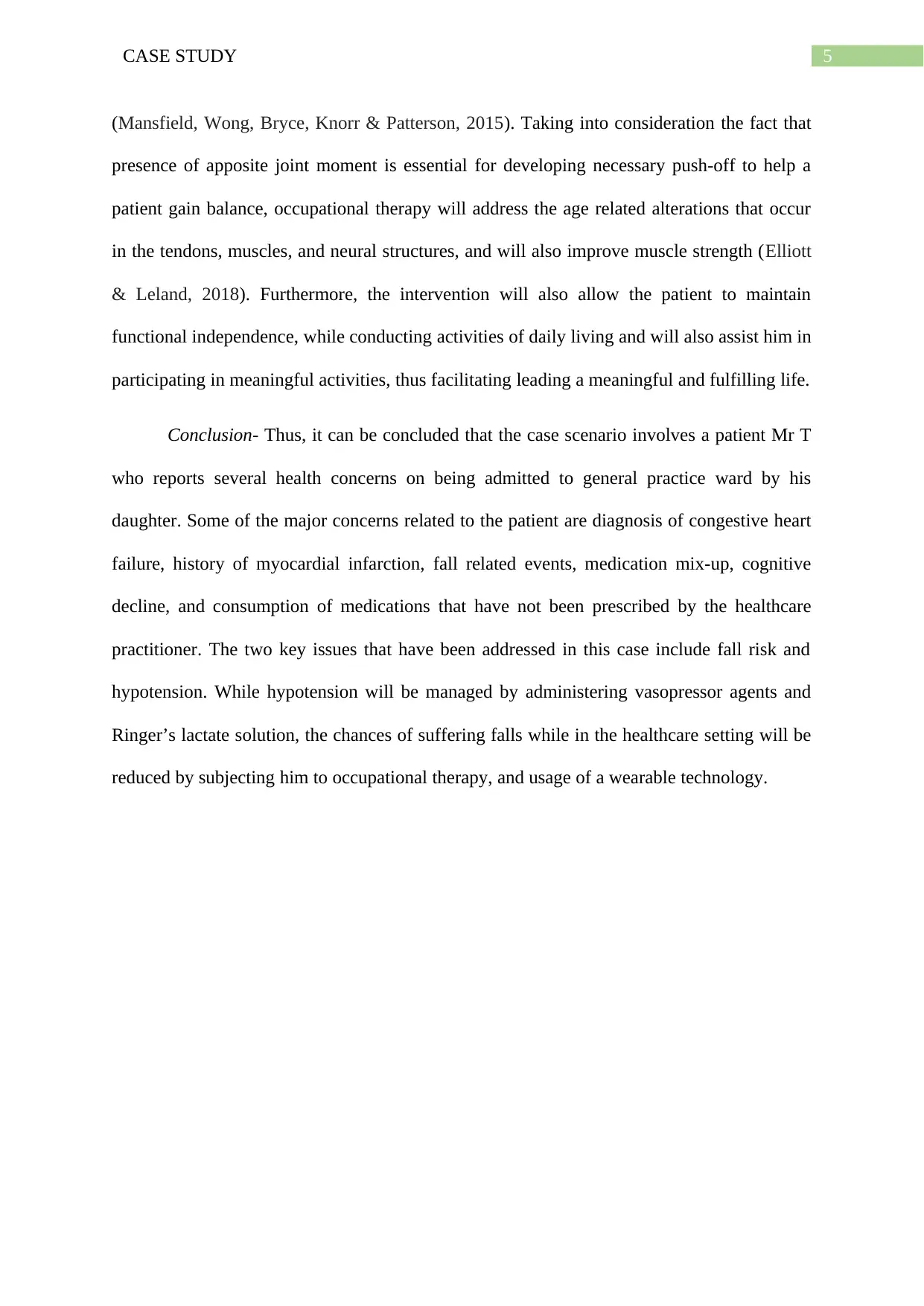
5CASE STUDY
(Mansfield, Wong, Bryce, Knorr & Patterson, 2015). Taking into consideration the fact that
presence of apposite joint moment is essential for developing necessary push-off to help a
patient gain balance, occupational therapy will address the age related alterations that occur
in the tendons, muscles, and neural structures, and will also improve muscle strength (Elliott
& Leland, 2018). Furthermore, the intervention will also allow the patient to maintain
functional independence, while conducting activities of daily living and will also assist him in
participating in meaningful activities, thus facilitating leading a meaningful and fulfilling life.
Conclusion- Thus, it can be concluded that the case scenario involves a patient Mr T
who reports several health concerns on being admitted to general practice ward by his
daughter. Some of the major concerns related to the patient are diagnosis of congestive heart
failure, history of myocardial infarction, fall related events, medication mix-up, cognitive
decline, and consumption of medications that have not been prescribed by the healthcare
practitioner. The two key issues that have been addressed in this case include fall risk and
hypotension. While hypotension will be managed by administering vasopressor agents and
Ringer’s lactate solution, the chances of suffering falls while in the healthcare setting will be
reduced by subjecting him to occupational therapy, and usage of a wearable technology.
(Mansfield, Wong, Bryce, Knorr & Patterson, 2015). Taking into consideration the fact that
presence of apposite joint moment is essential for developing necessary push-off to help a
patient gain balance, occupational therapy will address the age related alterations that occur
in the tendons, muscles, and neural structures, and will also improve muscle strength (Elliott
& Leland, 2018). Furthermore, the intervention will also allow the patient to maintain
functional independence, while conducting activities of daily living and will also assist him in
participating in meaningful activities, thus facilitating leading a meaningful and fulfilling life.
Conclusion- Thus, it can be concluded that the case scenario involves a patient Mr T
who reports several health concerns on being admitted to general practice ward by his
daughter. Some of the major concerns related to the patient are diagnosis of congestive heart
failure, history of myocardial infarction, fall related events, medication mix-up, cognitive
decline, and consumption of medications that have not been prescribed by the healthcare
practitioner. The two key issues that have been addressed in this case include fall risk and
hypotension. While hypotension will be managed by administering vasopressor agents and
Ringer’s lactate solution, the chances of suffering falls while in the healthcare setting will be
reduced by subjecting him to occupational therapy, and usage of a wearable technology.
⊘ This is a preview!⊘
Do you want full access?
Subscribe today to unlock all pages.

Trusted by 1+ million students worldwide
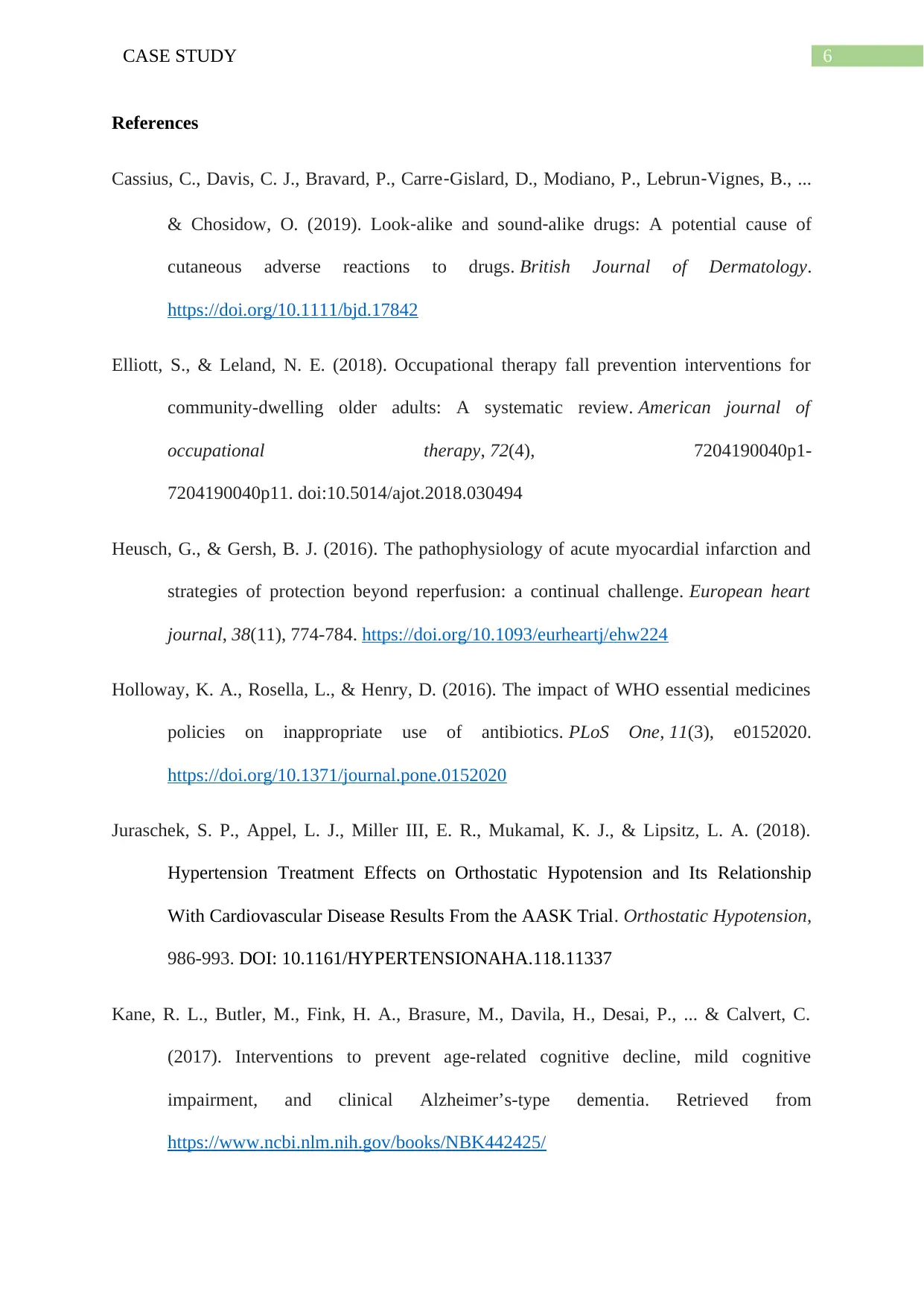
6CASE STUDY
References
Cassius, C., Davis, C. J., Bravard, P., Carre‐Gislard, D., Modiano, P., Lebrun‐Vignes, B., ...
& Chosidow, O. (2019). Look‐alike and sound‐alike drugs: A potential cause of
cutaneous adverse reactions to drugs. British Journal of Dermatology.
https://doi.org/10.1111/bjd.17842
Elliott, S., & Leland, N. E. (2018). Occupational therapy fall prevention interventions for
community-dwelling older adults: A systematic review. American journal of
occupational therapy, 72(4), 7204190040p1-
7204190040p11. doi:10.5014/ajot.2018.030494
Heusch, G., & Gersh, B. J. (2016). The pathophysiology of acute myocardial infarction and
strategies of protection beyond reperfusion: a continual challenge. European heart
journal, 38(11), 774-784. https://doi.org/10.1093/eurheartj/ehw224
Holloway, K. A., Rosella, L., & Henry, D. (2016). The impact of WHO essential medicines
policies on inappropriate use of antibiotics. PLoS One, 11(3), e0152020.
https://doi.org/10.1371/journal.pone.0152020
Juraschek, S. P., Appel, L. J., Miller III, E. R., Mukamal, K. J., & Lipsitz, L. A. (2018).
Hypertension Treatment Effects on Orthostatic Hypotension and Its Relationship
With Cardiovascular Disease Results From the AASK Trial. Orthostatic Hypotension,
986-993. DOI: 10.1161/HYPERTENSIONAHA.118.11337
Kane, R. L., Butler, M., Fink, H. A., Brasure, M., Davila, H., Desai, P., ... & Calvert, C.
(2017). Interventions to prevent age-related cognitive decline, mild cognitive
impairment, and clinical Alzheimer’s-type dementia. Retrieved from
https://www.ncbi.nlm.nih.gov/books/NBK442425/
References
Cassius, C., Davis, C. J., Bravard, P., Carre‐Gislard, D., Modiano, P., Lebrun‐Vignes, B., ...
& Chosidow, O. (2019). Look‐alike and sound‐alike drugs: A potential cause of
cutaneous adverse reactions to drugs. British Journal of Dermatology.
https://doi.org/10.1111/bjd.17842
Elliott, S., & Leland, N. E. (2018). Occupational therapy fall prevention interventions for
community-dwelling older adults: A systematic review. American journal of
occupational therapy, 72(4), 7204190040p1-
7204190040p11. doi:10.5014/ajot.2018.030494
Heusch, G., & Gersh, B. J. (2016). The pathophysiology of acute myocardial infarction and
strategies of protection beyond reperfusion: a continual challenge. European heart
journal, 38(11), 774-784. https://doi.org/10.1093/eurheartj/ehw224
Holloway, K. A., Rosella, L., & Henry, D. (2016). The impact of WHO essential medicines
policies on inappropriate use of antibiotics. PLoS One, 11(3), e0152020.
https://doi.org/10.1371/journal.pone.0152020
Juraschek, S. P., Appel, L. J., Miller III, E. R., Mukamal, K. J., & Lipsitz, L. A. (2018).
Hypertension Treatment Effects on Orthostatic Hypotension and Its Relationship
With Cardiovascular Disease Results From the AASK Trial. Orthostatic Hypotension,
986-993. DOI: 10.1161/HYPERTENSIONAHA.118.11337
Kane, R. L., Butler, M., Fink, H. A., Brasure, M., Davila, H., Desai, P., ... & Calvert, C.
(2017). Interventions to prevent age-related cognitive decline, mild cognitive
impairment, and clinical Alzheimer’s-type dementia. Retrieved from
https://www.ncbi.nlm.nih.gov/books/NBK442425/
Paraphrase This Document
Need a fresh take? Get an instant paraphrase of this document with our AI Paraphraser
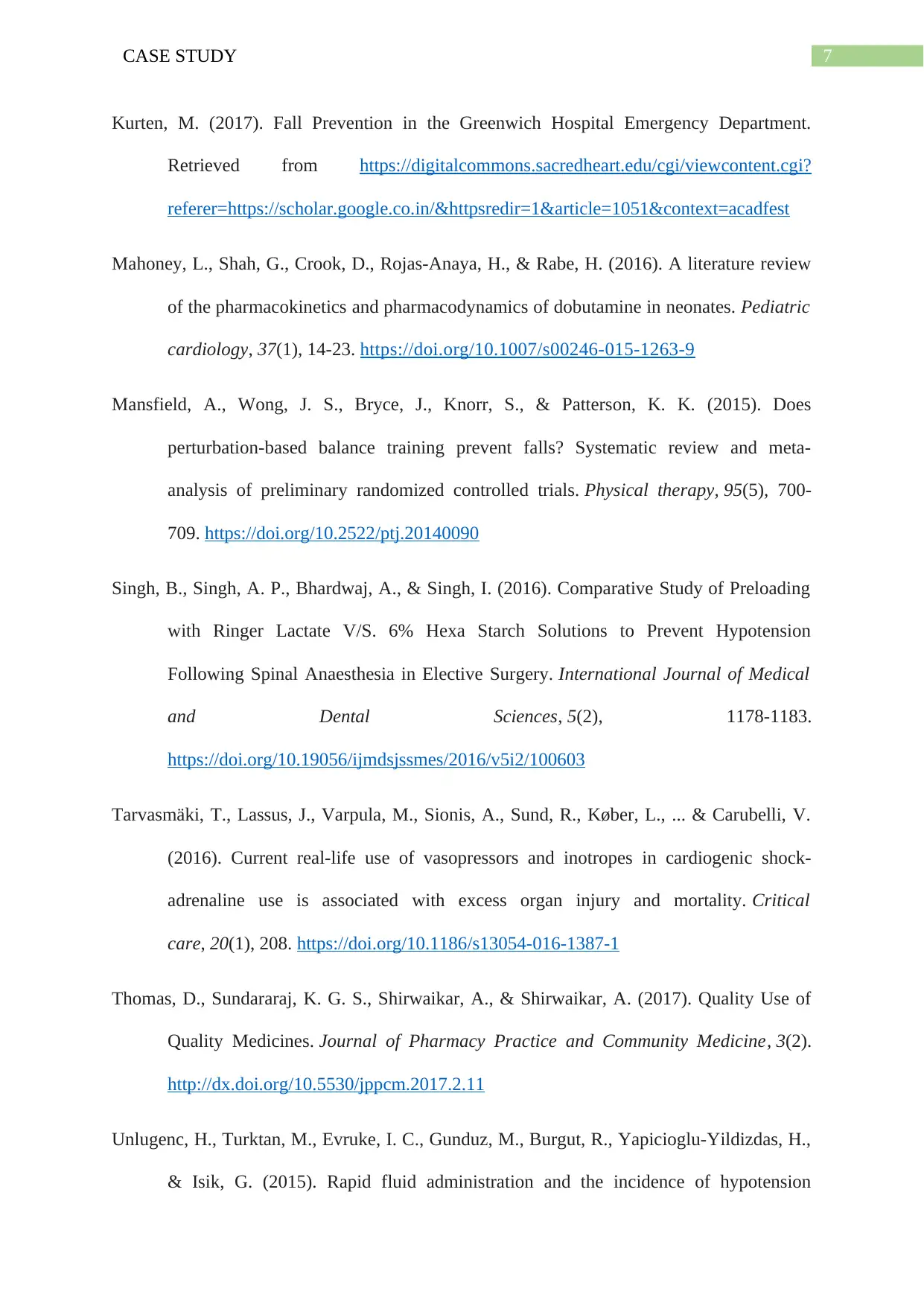
7CASE STUDY
Kurten, M. (2017). Fall Prevention in the Greenwich Hospital Emergency Department.
Retrieved from https://digitalcommons.sacredheart.edu/cgi/viewcontent.cgi?
referer=https://scholar.google.co.in/&httpsredir=1&article=1051&context=acadfest
Mahoney, L., Shah, G., Crook, D., Rojas-Anaya, H., & Rabe, H. (2016). A literature review
of the pharmacokinetics and pharmacodynamics of dobutamine in neonates. Pediatric
cardiology, 37(1), 14-23. https://doi.org/10.1007/s00246-015-1263-9
Mansfield, A., Wong, J. S., Bryce, J., Knorr, S., & Patterson, K. K. (2015). Does
perturbation-based balance training prevent falls? Systematic review and meta-
analysis of preliminary randomized controlled trials. Physical therapy, 95(5), 700-
709. https://doi.org/10.2522/ptj.20140090
Singh, B., Singh, A. P., Bhardwaj, A., & Singh, I. (2016). Comparative Study of Preloading
with Ringer Lactate V/S. 6% Hexa Starch Solutions to Prevent Hypotension
Following Spinal Anaesthesia in Elective Surgery. International Journal of Medical
and Dental Sciences, 5(2), 1178-1183.
https://doi.org/10.19056/ijmdsjssmes/2016/v5i2/100603
Tarvasmäki, T., Lassus, J., Varpula, M., Sionis, A., Sund, R., Køber, L., ... & Carubelli, V.
(2016). Current real-life use of vasopressors and inotropes in cardiogenic shock-
adrenaline use is associated with excess organ injury and mortality. Critical
care, 20(1), 208. https://doi.org/10.1186/s13054-016-1387-1
Thomas, D., Sundararaj, K. G. S., Shirwaikar, A., & Shirwaikar, A. (2017). Quality Use of
Quality Medicines. Journal of Pharmacy Practice and Community Medicine, 3(2).
http://dx.doi.org/10.5530/jppcm.2017.2.11
Unlugenc, H., Turktan, M., Evruke, I. C., Gunduz, M., Burgut, R., Yapicioglu-Yildizdas, H.,
& Isik, G. (2015). Rapid fluid administration and the incidence of hypotension
Kurten, M. (2017). Fall Prevention in the Greenwich Hospital Emergency Department.
Retrieved from https://digitalcommons.sacredheart.edu/cgi/viewcontent.cgi?
referer=https://scholar.google.co.in/&httpsredir=1&article=1051&context=acadfest
Mahoney, L., Shah, G., Crook, D., Rojas-Anaya, H., & Rabe, H. (2016). A literature review
of the pharmacokinetics and pharmacodynamics of dobutamine in neonates. Pediatric
cardiology, 37(1), 14-23. https://doi.org/10.1007/s00246-015-1263-9
Mansfield, A., Wong, J. S., Bryce, J., Knorr, S., & Patterson, K. K. (2015). Does
perturbation-based balance training prevent falls? Systematic review and meta-
analysis of preliminary randomized controlled trials. Physical therapy, 95(5), 700-
709. https://doi.org/10.2522/ptj.20140090
Singh, B., Singh, A. P., Bhardwaj, A., & Singh, I. (2016). Comparative Study of Preloading
with Ringer Lactate V/S. 6% Hexa Starch Solutions to Prevent Hypotension
Following Spinal Anaesthesia in Elective Surgery. International Journal of Medical
and Dental Sciences, 5(2), 1178-1183.
https://doi.org/10.19056/ijmdsjssmes/2016/v5i2/100603
Tarvasmäki, T., Lassus, J., Varpula, M., Sionis, A., Sund, R., Køber, L., ... & Carubelli, V.
(2016). Current real-life use of vasopressors and inotropes in cardiogenic shock-
adrenaline use is associated with excess organ injury and mortality. Critical
care, 20(1), 208. https://doi.org/10.1186/s13054-016-1387-1
Thomas, D., Sundararaj, K. G. S., Shirwaikar, A., & Shirwaikar, A. (2017). Quality Use of
Quality Medicines. Journal of Pharmacy Practice and Community Medicine, 3(2).
http://dx.doi.org/10.5530/jppcm.2017.2.11
Unlugenc, H., Turktan, M., Evruke, I. C., Gunduz, M., Burgut, R., Yapicioglu-Yildizdas, H.,
& Isik, G. (2015). Rapid fluid administration and the incidence of hypotension
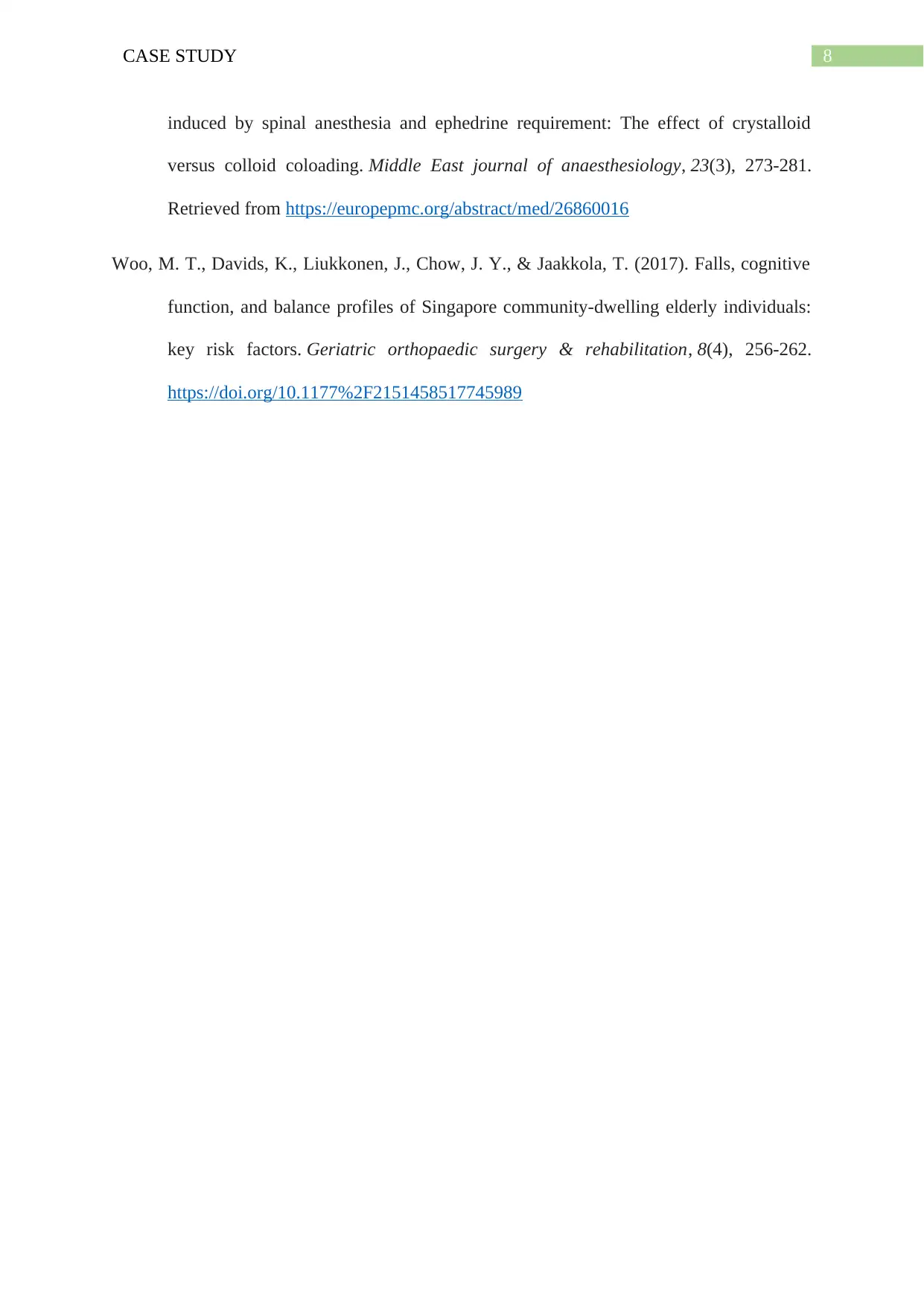
8CASE STUDY
induced by spinal anesthesia and ephedrine requirement: The effect of crystalloid
versus colloid coloading. Middle East journal of anaesthesiology, 23(3), 273-281.
Retrieved from https://europepmc.org/abstract/med/26860016
Woo, M. T., Davids, K., Liukkonen, J., Chow, J. Y., & Jaakkola, T. (2017). Falls, cognitive
function, and balance profiles of Singapore community-dwelling elderly individuals:
key risk factors. Geriatric orthopaedic surgery & rehabilitation, 8(4), 256-262.
https://doi.org/10.1177%2F2151458517745989
induced by spinal anesthesia and ephedrine requirement: The effect of crystalloid
versus colloid coloading. Middle East journal of anaesthesiology, 23(3), 273-281.
Retrieved from https://europepmc.org/abstract/med/26860016
Woo, M. T., Davids, K., Liukkonen, J., Chow, J. Y., & Jaakkola, T. (2017). Falls, cognitive
function, and balance profiles of Singapore community-dwelling elderly individuals:
key risk factors. Geriatric orthopaedic surgery & rehabilitation, 8(4), 256-262.
https://doi.org/10.1177%2F2151458517745989
⊘ This is a preview!⊘
Do you want full access?
Subscribe today to unlock all pages.

Trusted by 1+ million students worldwide
1 out of 9
Related Documents
Your All-in-One AI-Powered Toolkit for Academic Success.
+13062052269
info@desklib.com
Available 24*7 on WhatsApp / Email
![[object Object]](/_next/static/media/star-bottom.7253800d.svg)
Unlock your academic potential
Copyright © 2020–2025 A2Z Services. All Rights Reserved. Developed and managed by ZUCOL.




